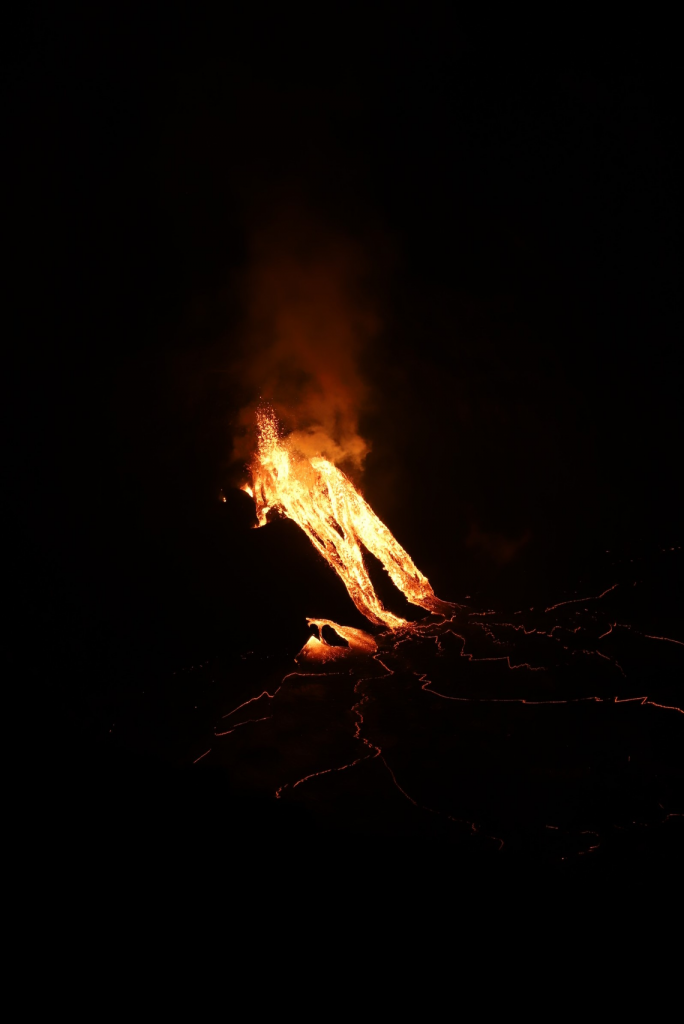Kīlauea Volcano’s West Vent Erupting More Vigorously Overnight While North Vent Quieted

Early Saturday morning, the west vent of Kīlauea Volcano on the Big Island reactivated with lava flow while the north vent quieted and started to drain the Halemaʻumaʻu crater lake, according to a Saturday morning report from the Hawaiian Volcano Observatory.
Observations of the Halemaʻumaʻu crater revealed the north vent continued erupting lava into the lake within the crater. The west vent was incandescent (emitting light) until about 2:40 am Saturday (nearly coincident with the switch from deflationary to inflationary summit tilt). Then it became vigorously active with up to 3 narrow streams flowing into the lake . After 3 am the north vent quieted and started to slowly drain lava from the lake.
Webcam views of the lava lake can be found here: https://volcanoes.usgs.gov/volcanoes/kilauea/multimedia_webcams.html.
Reduced sulfur dioxide (SO2) emissions were measured Friday night, with preliminary analysis showing rates dropping to 16,000-20,000 tonnes/day.
As of 2 pm Friday, the crater lake was still 577 feet deep, with the lake level appearing to be 6 feet lower with a narrow black ledge around the north edge. The lava lake was about 1,360 feet below the crater’s rim as of Friday.
Seismicity remains elevated but stable, with a few minor earthquakes and tremor fluctuations related to the vigor of fissure fountaining of lava.
The lava lake volume remained about 21 million cubic meters (27 million cubic yards or 4.8 billion gallons). Field crews from the US Geological Survey are currently making measurements to confirm whether the lake surface continues to drop.

An island of cooler solidified lava, which is floating in the lava lake, had been drifting slowly northeastward in the lake. It apparently grounded itself near the north vent. It is still about 850 feet in length and 375 feet in width based on the Dec. 23 thermal map (https://www.usgs.gov/maps/december-23-2020-k-lauea-summit-eruption-thermal-map). At about 6 am Saturday, the island started to slowly drift to the southeast.
Hazard Analysis: High levels of volcanic gas, rockfalls, explosions and volcanic glass particles are the primary hazards of concern regarding this new activity at Kīlauea’s summit.
Large amounts of volcanic gas — primarily water vapor, carbon dioxide and sulfur dioxide — are continuously released during eruptions of Kīlauea Volcano. As sulfur dioxide is released from the summit during this new eruption, it will react in the atmosphere with oxygen, sunlight, moisture and other gases and particles, and within hours to days, convert to fine particles.
The particles scatter sunlight and cause the visible haze that has been observed downwind of Kīlauea, known as vog (volcanic smog), during previous summit eruptions. Vog creates the potential for airborne health hazards to residents and visitors, damages agricultural crops and other plants, and affects livestock operations.
Rockfalls and minor explosions, such as the ones that occurred during the 2008–2018 lava lake eruption at Kīlauea summit, may occur suddenly and without warning. This underscores the extremely hazardous nature of Kīlauea caldera rim surrounding Halemaʻumaʻu crater, an area that has been closed to the public since late 2007.
Pele’s hair and other lightweight volcanic glass fragments from the lava fountains within Halemaʻumaʻu will fall downwind of the fissure vents and lava lake, dusting the ground within a few hundred yards of the vent. High winds may waft lighter particles to greater distances. Residents are urged to minimize exposure to these volcanic particles, which can cause skin and eye irritation similar to volcanic ash.
Vog information can be found at https://vog.ivhhn.org/.
The Hawaii Volcanoes National Park issued guidelines: “How to Safely View the New Eruption in Hawaiʻi Volcanoes National Park” at https://www.nps.gov/havo/learn/news/20201221_nr_new-summit-eruption-kilauea.htm.
The Hawaiian Volcano Observatory continues to closely monitor Kīlauea’s seismicity, deformation and gas emissions for any sign of reactivation, and maintains visual surveillance of the summit and the East Rift Zone.









